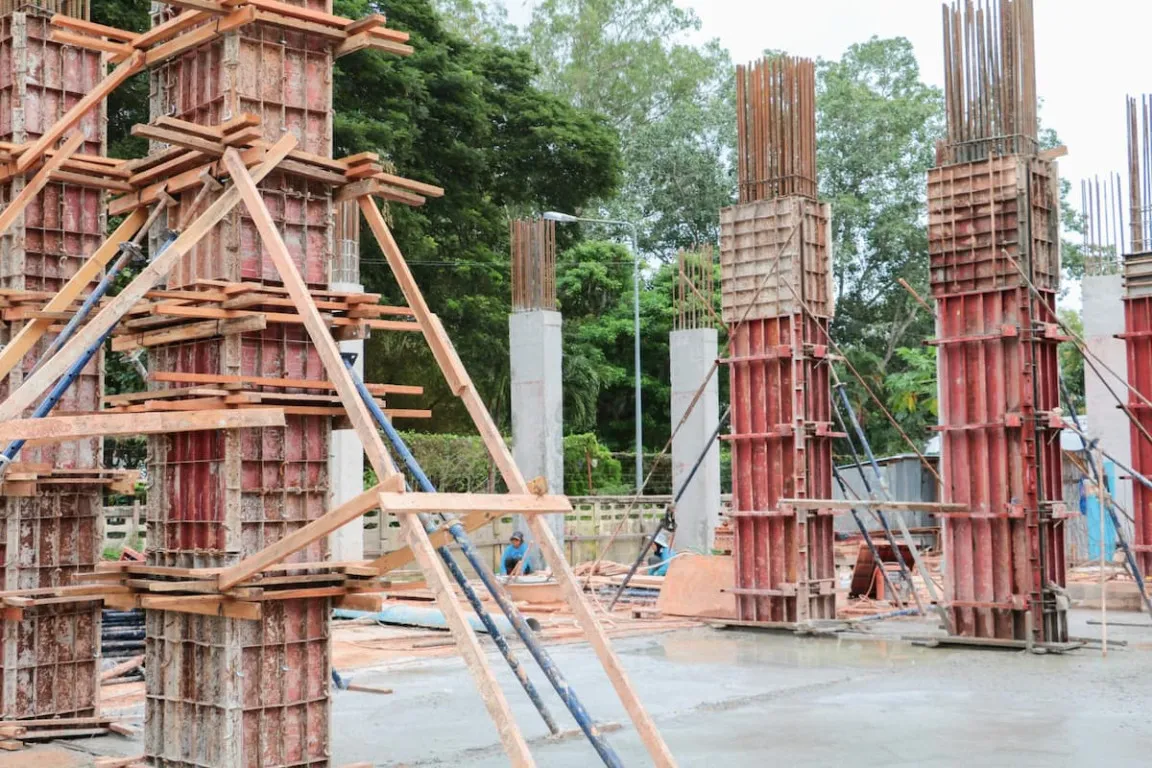When discussing the structure of a building, it is essential not to overlook the vertical support elements, commonly referred to as columns. In the manufacturing process, a temporary support system in the form of column formwork is needed.
Although temporary, the selection and application of column formwork will affect the success of a construction project. This is because this system will have a direct impact on work efficiency and the final quality of the building columns.
So, what is the purpose of column formwork, and how is it installed? To fully understand the concept and apply it correctly, see the explanation below.
What Is Column Formwork?
Column formwork is a temporary structure that serves to shape and support concrete so that it can harden properly. With this structure, building columns will form dimensions that match the initial design.
In general, column formwork is placed around concrete columns, and its installation is assisted by a connector system.
In fact, column formwork comes in several shapes, ranging from square, rectangular, to circular. The choice of formwork depends on the needs of the building construction project.
Types of Column Formwork
It is important to note that column formwork types are distinguished by the materials used to create them. In order to choose the right type, construction project workers must consider the project requirements, structural design, speed of execution, and material sustainability.
In general, column formwork can be divided into the following types:
1. Wooden Column Formwork
Wooden formwork is the most widely used type of formwork in the construction of building columns. If you are looking for a practical column formwork option, this type may be the solution.
As the name suggests, wooden column formwork is made of wood, making it relatively affordable and accessible. Wooden formwork is commonly found in traditional Japanese houses.
However, it is important to note that wooden formwork is more susceptible to deformation, which means changes in shape, size, or position due to humidity and wood-eating organisms. This makes it less durable than metal formwork.
2. Plastic Column Formwork
Because it is made of plastic, this formwork is relatively light, making it easy to install and dismantle. In addition, plastic material also has good resistance to environmental conditions, including preventing potential corrosion.
However, you can use plastic formwork if you are carrying out a small-scale construction project or one involving simple shapes. This is because the strength of plastic material is not as good as metal or steel.
3. Steel Column Formwork
Steel is known as a sturdy and stable material, so it is often relied upon in large-scale construction projects. Steel formwork can even be reused in other construction projects.
However, keep in mind that if you want to use steel formwork, make sure you have sufficient funds, because this type of formwork is more expensive than other types.
4. Fiberglass Column Formwork
Did you know that fiberglass formwork is the latest innovation that can meet the needs of complex building shapes and structures? This is supported by its lightweight material and resistance to corrosion and concrete pressure.
Interestingly, fiberglass is known as a sustainable material because it can be permeated by light, thereby reducing the need for lighting during the casting process.
If you want a smooth, precise, and aesthetically pleasing surface finish, fiberglass formwork is the right solution. However, like steel formwork, fiberglass formwork can be quite expensive.
Functions of Column Formwork
In fact, column formwork not only contributes to the strength of a building's structure but also to its appearance. Here are some functions of column formwork that you need to know:
- Providing the right shape and dimensions for concrete: With column formwork, wet concrete can be held in the correct and stable position so that columns with precise dimensions are formed.
- Supports structural stability and integrity: Column formwork contributes to the creation of building columns that are not easily shaken and can last for a long time.
- Simplifies the work process: The use of proper column formwork helps the concrete casting process run in a structured and controlled manner. This is because this system will help keep the reinforcement in the correct position and shorten the construction time.
- Supports safety in the work area: With the creation of a sturdy and stable concrete structure, the risk of property damage can be minimized. This will certainly reduce the risk of injury to workers.
Read also: Know the Ideal Practical Column Spacing for Sturdy Building
Main Components of Column Formwork
To produce concrete columns with the right shape, accurate dimensions, and guaranteed strength, column formwork must have several components, including:
1. Panels
Panels are the main component of column formwork, usually made of steel, wood, or other composite materials. Composite materials refer to manufactured materials that combine two or more materials.
The function of panels is to provide a structural shape to building columns, which can be square, rectangular, or circular.
It should be noted that panels are designed to be modular and versatile. Therefore, you can reuse them in other construction projects.
2. Ties and Wedges
These two components serve to ensure that the formwork remains sturdy and stable during the casting process.
Ties are made to secure the formwork panels while providing the space needed for the binding process during the pre-fabrication stage. Meanwhile, wedges are connectors for the formwork panel boxes and protectors for the formwork to remain in the expected position.
3. Anchors
Anchors are components embedded in the concrete structure to ensure that the formwork is in the right place and stands stably. These components are present during the formwork placement process and when the formwork is removed from the concrete structure.
4. Clamps or Yokes
Clamps are components that hold and maintain the stability of formwork panels during the concrete casting process. With clamps, the formwork remains sturdy and does not shift or deform due to the pressure of fresh concrete.
5. Double-headed Jacks
This component can be used if you need an adjustable load support, for example, when you have to remove column formwork components.
Jacks help other structural elements, such as ceilings, remain stable in their position, thereby preventing accidents during the construction process.
Advantages and Disadvantages of Column Formwork
Among the advantages of column formwork are:
- It can be used for columns of various sizes.
- It can be adjusted to the desired shape and size of the column.
- It has good strength and durability.
- The price is relatively affordable.
The disadvantages of column formwork systems include:
- The installation process tends to be complicated.
- Requires the assistance of many workers.
- At risk of damage if the installation technique is incorrect.
Read also: Construction Engineering: Its Function, Types, & Example!
How to Install Column Formwork
To install column formwork correctly and get optimal results, you need to follow these steps:
1. Prepare Tools and Materials
In this first step, you need to prepare formwork materials that are suitable for the project requirements, cut the formwork panels to the required size, and check the condition of the anchors. Do not forget to prepare clamps and props as well.
Next, clean the column placement area of any debris that could interfere with the casting process.
2. Installing the Formwork
Begin by installing the formwork panels in sequence around the column. Remember, you must ensure that they are installed tightly and perpendicular to each other.
Use ties and wedges to secure the panels and ensure that all joints are properly locked. Next, embed the anchors into the supporting structure, whether it be soil or something else, to stabilize the formwork.
3. Pouring Concrete
Pour the concrete mixture into the column formwork slowly and evenly so that there are no air pockets inside. To ensure that the concrete seeps evenly into the formwork, you can use a concrete compactor.
4. Providing Maintenance
After the casting process, perform simple maintenance efforts, such as watering or protecting from extreme weather. This is intended so that the concrete hardening process runs optimally. Wait until the concrete is completely hardened, strong, and looks stable.
5. Dismantling the Formwork
If the concrete is considered strong and stable enough, you can remove the ties, wedges, and clamps. Next, remove the panels sequentially and slowly to avoid damage to the concrete structure.
That is all the explanation of column formwork, a vital system in reinforced concrete buildings. Various factors contribute to the success of this system, from the accuracy of material selection, how to calculate column formwork to installation techniques.
However, in addition to these factors, material quality is also a crucial element that you must always prioritize. To obtain quality materials that support optimal construction projects, you can rely on products from Semen Merah Putih.
Through one of its subsidiaries, Beton Merah Putih, Semen Merah Putih provides innovative ready-to-use concrete products designed for a variety of unique and robust applications with its flagship products, namely Beton Ready Mix and Beton Precast.
Merah Putih Beton's ready-to-use concrete products are designed for various applications according to consumer demand. They are available in a range of qualities for various construction projects, such as industrial, commercial, and infrastructure, including the construction of multi-story buildings, housing, highways, and other constructions.
Contact us immediately to get complete information about other Semen Merah Putih products and find the best solution for your construction project!
Read also: Precast Concrete: Definition, Functions, and Types



